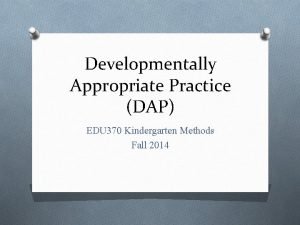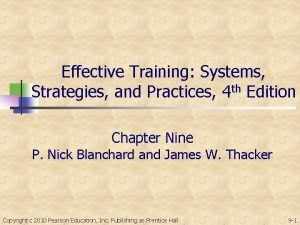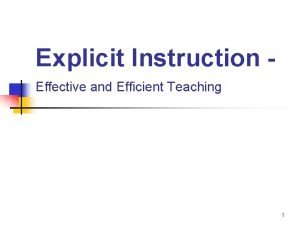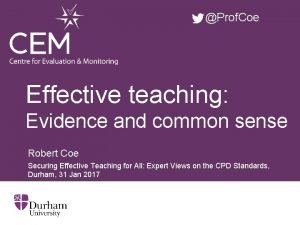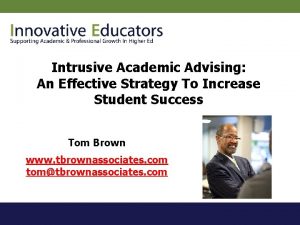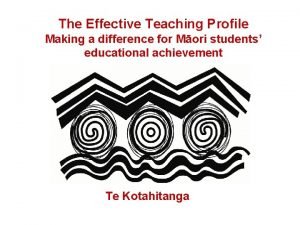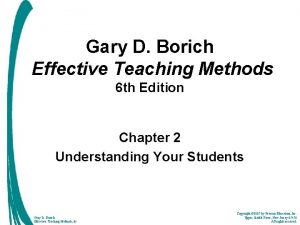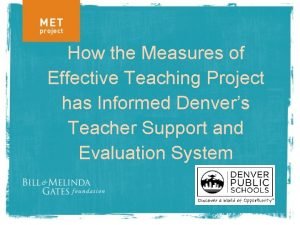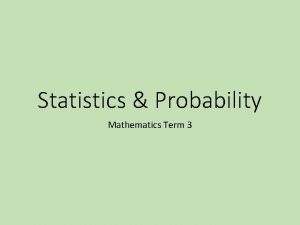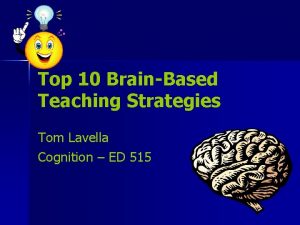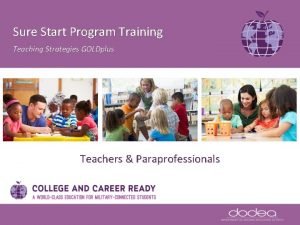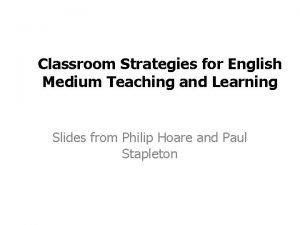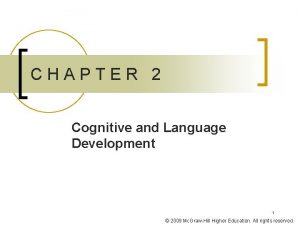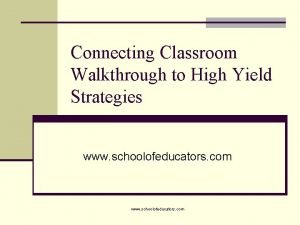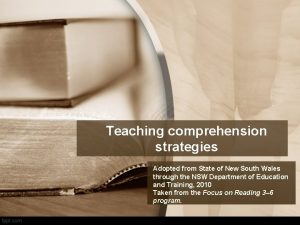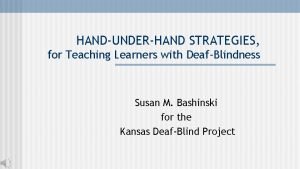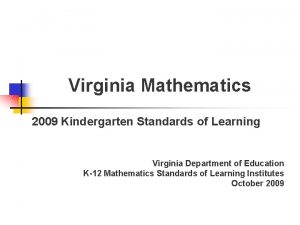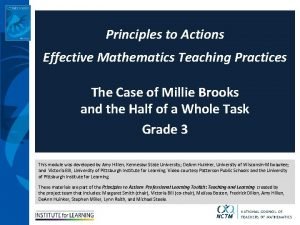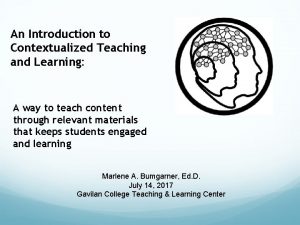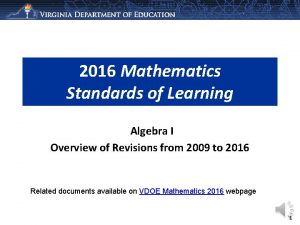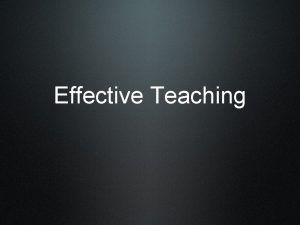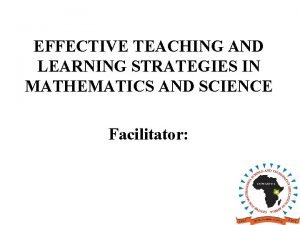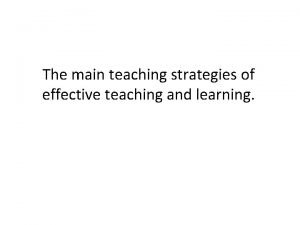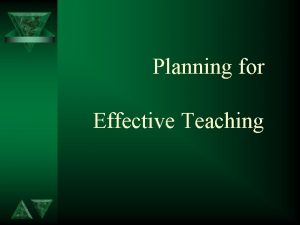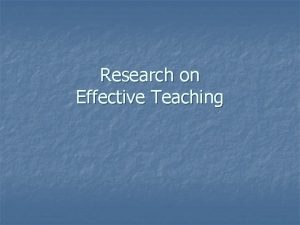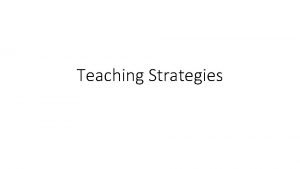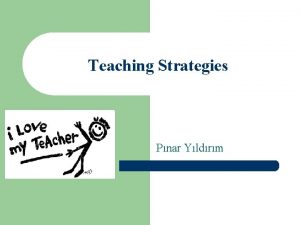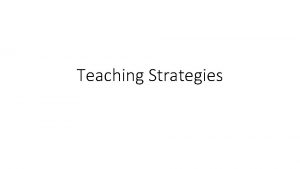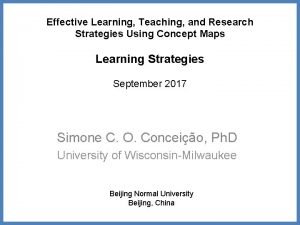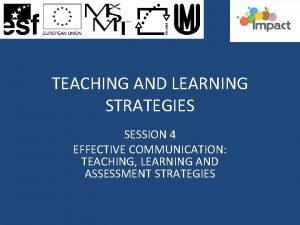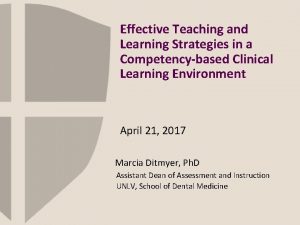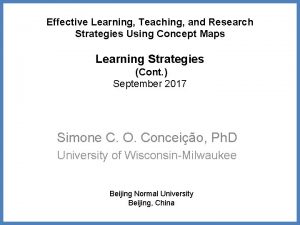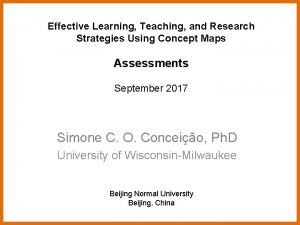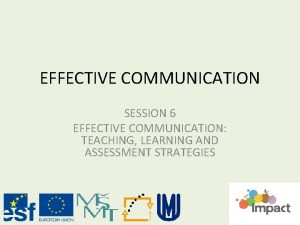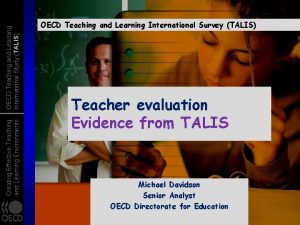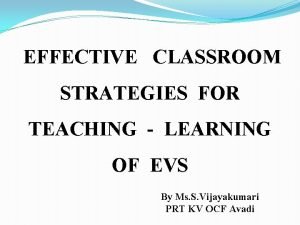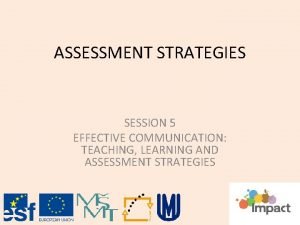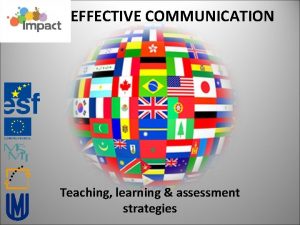EFFECTIVE TEACHING AND LEARNING STRATEGIES IN MATHEMATICS AND


























- Slides: 26

EFFECTIVE TEACHING AND LEARNING STRATEGIES IN MATHEMATICS AND SCIENCE Facilitator:

Rationale: • Competency Based Curriculum (CBC) requires learners to engage in Inquiry Based Learning (IBL) to develop the requisite (core) competences • IBL can help learners become more creative, more positive and more independent

Rationale (cont’) • This unit provides you with an opportunity to reflect on your teaching practices in relation to the strategies you employ with a view to identifying how they can be enhanced to promote IBL.

Learning outcome • By the end of the session, you should be able to demonstrate understanding of inquiry based pedagogical skills.

Reflection: • What do you understand by Inquiry Based approach in teaching and learning? • IBL is an approach that encourages learners to explore, ask questions, share ideas and make conclusions. It builds their critical thinking and problem solving skills as well as selfesteem and self-efficacy.

• IBL can be summarized as shown below •

Characteristics of Inquiry- Based lesson • Creating key inquiry question/hypothesis/ scenario • Designing and carrying out an experiment or investigation to obtain data that help answer the question • Analyze, interpret data and explain the findings • Connecting the explanations to the knowledge obtained from the investigative process • Creating an argument and justification for explanation

Levels of Inquiry Based Learning 1. Confirmatory inquiry: • Teacher has absolute control over every phase of the process, and makes all the decisions. • Students are provided with the key inquiry question to be answered, the procedure as well as the results of an investigation. • The teacher also provides all the necessary information, materials and apparatus and asks the students to carry out the procedure.

Confirmatory Activity Examples Biology • Question: What is the effect of light on the rate of photosynthesis? • Procedure: The teacher to provide students with materials, procedure and the diagram of a set up that can be used to show that when the intensity of light increases, the rate of photosynthesis increases. •

Confirmatory Activity The teacher asks the students to conduct the experiment using the procedure and record the results Chemistry Question: What is the effect of surface area on the rate of reaction? The teacher provide students with materials, procedure and the diagram of a set up. Students are asked to conduct the experiment using the procedure and make observations in balloons.

Confirmatory Activity Physics Verifying Hooke’s laws What is the spring constant for the spring provided? Procedure: Suspend different loads on the spring balance provided. Record the load and the extension of the spring. Plot a graph of load against the extension

Mathematics Question Expand (a+ b) 2 Procedure The teacher provides the diagram and students find the area of the sections The idea of area of is used to confirm that (a+ b) 2 =a 2+2 ab+b 2 Steps are given to the learners to arrive at the above answer

2. Structured inquiry • Learners are provided with key inquiry question, methods and materials and are challenged to discover relationships between given variables. Activity – Propose an activity to show the structured level of IBL

3. Guided inquiry • Learners are provided with a key inquiry question. • However, the method for research is up to the students to develop. Activity – Propose an activity to show the guided level of IBL

4. Open inquiry • Phenomena is proposed to learners, but learners must develop their own key inquiry question and method for research to discover relationships among variables. Activity – Propose an activity to show the open level of IBL

5 E Instructional Model • Is based on the constructivist approach to learning which states that learners build or construct new ideas on top of old ideas. • The constructivism strategy draws on learners’ existing knowledge, beliefs, and skills with learners synthesizing new understanding from prior learning/experiences and new information • In 5 E model, the teacher presents learning experiences with problematic, challenging but achievable situations that are slightly beyond the current level of understanding of learners.

• The teacher monitors learner’s exploration guides their inquiry and promotes new patterns of thinking in a systematic way.

Elements and strategies of 5 E Model Engage Purpose • Arouse curiosity and generate interest • Elicit prior knowledge • Connect to prior knowledge • Set the objective of the lesson Activities • Assessing and tapping into what students know or think about the topic • Asking key questions and encouraging responses

Explore Purpose • Probing, inquiring, and questioning experiences; leading to discovery of new knowledge and skills • Establish conceptual relationships and understanding Activities • Conducting activities (hands-on, & minds-on) • Predicting and forming hypotheses or making generalizations • Recording observations and/or generalizations

• Sharing ideas and suspending judgment • Discussing tentative alternatives Explain • Purpose • Connecting prior knowledge and background to new discoveries • Communicating new understandings/ concepts • Connecting informal language to formal language

Activities • Explaining, listening, defining, and asking questions • Using previous observations and findings • Providing reasonable responses to questions • Interacting in a positive, supportive manner

Elaborate/ Extend Purpose • Application of new learning to a new or similar situation • Extend and explain concept being explored • Communicate new understanding with formal language • Make conceptual connections

Activities • Applying new terms and definitions • Using previous information to probe, ask questions, and make reasonable judgments • Providing reasonable conclusions and solutions • Recording observations, explanations, and solutions

• Evaluate • Purpose • Assess understanding (Self, peer and teacher evaluation) • Demonstrate understanding of new concept by observation or open ended response • Apply within problem situation • Show evidence of accomplishment

Conclusion • In this unit, Inquiry Based Learning and 5 E Instructional Model have been discussed. • These instructional approaches have the potential to revolutionize the teaching and learning of mathematics and science if well utilized. • In the subsequent subject sessions, opportunities will be provided to practice Inquiry Based Teaching and learning as well as 5 E Instructional Model

END
 10 effective dap teaching strategies
10 effective dap teaching strategies Effective training systems strategies and practices
Effective training systems strategies and practices Specific objectives of teaching mathematics
Specific objectives of teaching mathematics Approach in teaching
Approach in teaching Explicit instruction effective and efficient teaching
Explicit instruction effective and efficient teaching Effective teaching evidence and practice
Effective teaching evidence and practice Strategies for effective interpersonal communication
Strategies for effective interpersonal communication Intrusive academic advising
Intrusive academic advising Cuadro comparativo entre e-learning b-learning y m-learning
Cuadro comparativo entre e-learning b-learning y m-learning Te kotahitanga effective teaching profile
Te kotahitanga effective teaching profile Ethurom
Ethurom 10 principles of effective online teaching
10 principles of effective online teaching Measures of effective teaching project
Measures of effective teaching project Learning intentions and success criteria for mathematics
Learning intentions and success criteria for mathematics Definition of micro teaching
Definition of micro teaching Top 10 brain-based teaching strategies
Top 10 brain-based teaching strategies Teaching strategies gold
Teaching strategies gold Emi teaching strategies
Emi teaching strategies Piaget teaching strategies
Piaget teaching strategies Principles of remedial instruction
Principles of remedial instruction High yield teaching strategies
High yield teaching strategies Teaching comprehension strategies nsw
Teaching comprehension strategies nsw Deaf-blindness teaching strategies
Deaf-blindness teaching strategies Virginia kindergarten standards
Virginia kindergarten standards Establish mathematics goals to focus learning
Establish mathematics goals to focus learning Contextualized learning
Contextualized learning 2016 mathematics standards of learning
2016 mathematics standards of learning
